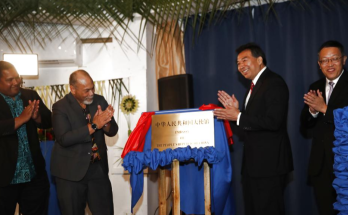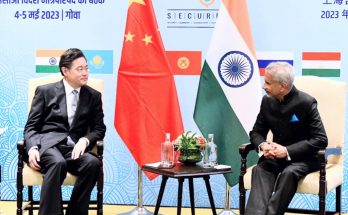
Delivering a keynote address to a mammoth gathering of 1500 people, that included 29 heads of the states and officials, entrepreneurs, financiers, academicians and journalists from over 130 countries including figures such as Russian President Vladimir Putin, UN Secretary-General Antonio Guterres, World Bank President Jim Yong Kim, and Managing Director of the International Monetary Fund Christine Lagarde, Chinese president Xi Jinping reminded people of Zhou Enlai’s speech at the Afro-Asian Conference at Bandung in April 1955 that was also represented by the 29 heads of the states. If India was the prime mover of the conference in Bandung, China is in the driver’s seat as far as the Belt and Road Forum is concerned, and India is conspicuously absent after it boycotted the Forum on the pretext of sovereignty.
The Silk Road spirit
In his address, Xi Jinping said “China’s construction of the Belt and Road Initiative is not to make a new start, but to connect development strategies of different countries and complement each other’s advantages … China is willing to share its development experience with all the rest of the world, but we will not intervene into other nation’s internal affairs, export our social system and development model, nor force others to accept them.” Reiterating the ‘Silk Road Spirit’, the Chinese president said, “Spanning thousands of miles and years, the ancient silk routes embody the spirit of peace and cooperation, openness and inclusiveness, mutual learning and mutual benefit.” Reassuring the gathering of China’s ‘peaceful rise’, he said, “We will not follow the old way of geopolitical games during the push for the Belt and Road Initiative, but create a new model of win-win and cooperation. It will not form a small group undermining stability, but is set to build a big family with harmonious co-existence.”
If at Bandung, Zhou Enlai was successful in smashing the international blockade by seeking commonalities between the nations, in Beijing Xi Jinping has been successful in smashing protectionism and convincing the nations about common development, the globalisation with Chinese characteristics, and even common security. In order to bulldoze the $1.4trillion ‘project of the century’, Xi Jinping pledged $14.49 billion more to the existing $40 billion Silk Road Fund founded in late 2014.The Development Bank of China and the Export-Import Bank of China has pledged to inject $124 billion in the Belt and Road Initiative to support infrastructure, financing and industrial capacity. This is understandable as China’s trade volume and investment with the Belt and Road Initiative countries in 2016, exceeded $3 trillion and $50billion respectively.
Why India is uneasy
India, which is considered as an important country by China along the ‘Belt and Road,’ perhaps went overboard to boycott the Forum. India’s dissatisfaction primarily originates from: 1) no policy consultations over the concept and, more importantly, the Bangladesh China India Myanmar Economic Corridor (BCIM) and the China Pakistan Economic Corridor (CPEC) that form part of the six Belt and Road Initiative economic corridors, especially the CPEC that runs through the Pakistan Occupied Kashmir (POK) parts of which are under Chinese jurisdiction. India considers POK as an integral part of Kashmir, the sovereignty of which has been decided by the Instrument of Accession in 1947. India has conveyed to China that there would be no compromise on the core issue of sovereignty in the same way as China has never budged on its ‘one China’ policy. 2) Since the China-Pakistan relationship is primarily considered as an anti-India axis, it believes that both will further pin down India. Thousands of Chinese soldiers operating in the POK territories go beyond the notions of connectivity and unimpeded trade. 3) Contrary to Xi Jinping’s overtures at the Forum that there is no geopolitics in the project, India sees it as China’s ambition to realise its long term vision for Asian regional and world order where given the nature of India-China asymmetrical relationship, and Sino-Pak entente cordiale, India’s strategic space would further shrink. In South Asian context, the ‘Indian centric’ fragmented integration according to the Chinese scholars has provided an opportunity to China to build the ‘community of common destiny’ with neighbouring countries proposed by Xi Jinping in 2014, which since then has been made integral to the construction of ‘Belt and Road.’ In fact Xi Jinping’s reference to ‘build a big family with harmonious co-existence’ just demonstrates that.
Given the rise of China, these concerns of India may be genuine. However, when India has rolled out its own connectivity initiatives such as the ‘Act East’ policy, ‘Look North’ policy that envisages India’s economic integration with the ASEAN and Central Asia. Projects such as India-Myanmar Friendship Road link which is part of the greater India-Myanmar-Thailand Trilateral Highway; the Kaladan Multimodal Transit Transport Project; the Mekong-India Corridor , which aims to connect India to Cambodia, Myanmar, Laos, and Vietnam; development of Sittwe port in southwestern part of Myanmar; master plan for integrating India’s Northeast to the ASEAN; India’s gas and pipeline projects, and more recently signed Chabahar port development with Iran has no conflict whatsoever with the similar Belt and Road projects.
In his address, Russian president Vladimir Putin said at the Belt and Road Forum in Beijing that ‘the integration of the Belt and Road Initiative, the Eurasian Economic Union (EEU), the Shanghai Cooperation Organization (SCO) and the ASEAN has laid the groundwork for building a great Eurasian partnership.’
Win-Win: Consultation & Dialogue
In order to reap win-win benefits, it is indeed essential to dock connectivity initiatives; I do not see any reason why India’s ‘Act East Policy’, ‘Look North Policy’ or any other domestic development strategy such as the ‘Sagarmala’ and ‘Make in India’ cannot be docked with other initiatives such as BRI, EEU, the US’ New Silk Road, and Japanese similar initiatives in the Central Asian region. On the other hand, and more importantly, India would be in a better position to implement above mentioned projects if its domestic drivers and production capacities are strengthened by aligning our development strategies with those of Chinese initiative, after all the AIIB, which India is the founder member has shelled out over $100 billion to support the BRI projects. India tends to gain rather than lose anything.
The CPEC is just a miniscule project in the scheme of ‘Belt and Road’ initiative. It would have been better to enhance India’s stake in the territory, had India shown interest in its joint development as the Japanese have shown in the Kuril Islands with Russia. At the same time China’s outreach to the Islamic world through Pakistan, and its quest for seeking a way out of Malacca dilemma is understandable.However, what is incomprehensible is China’s silence on policy consultation even if the same is an integral part of the ‘Five Connectivities’ of entire Initiative. It is a given fact that China-Pakistan ‘all weather’ strategic partnership; China wooing smaller South Asian countries, and China’s presence in the Indian Ocean Region are some of the reasons for the India-China rivalry in the region. However, if there are better consultation mechanisms between the two, some of the mistrust could be done away with.
It may be hoped that India’s boycott is just a one-time thing, but not the boycott of the entire ‘Belt and Road’ Initiative. Both India and China need each other, both have been contributing massively for the global economic growth. If they join hands, it will bring greater prosperity to their people, to the people of the region as well as the world. The new realities in the global and regional arena have demanded that they make space for each other in Asia Pacific. In the process, some collision and confrontation is imminent, but the same could be avoided by way of policy coordination and consultation and more so by establishing dialogue mechanisms at various levels.
Author Profile
- India Writes Network (www.indiawrites.org) is an emerging think tank and a media-publishing company focused on international affairs & the India Story. Centre for Global India Insights is the research arm of India Writes Network. To subscribe to India and the World, write to editor@indiawrites.org. A venture of TGII Media Private Limited, a leading media, publishing and consultancy company, IWN has carved a niche for balanced and exhaustive reporting and analysis of international affairs. Eminent personalities, politicians, diplomats, authors, strategy gurus and news-makers have contributed to India Writes Network, as also “India and the World,” a magazine focused on global affairs.
Latest entries
 DiplomacyApril 23, 2024Resetting West Asia, re-booting the world, but not fast enough: T.S. Tirumurti
DiplomacyApril 23, 2024Resetting West Asia, re-booting the world, but not fast enough: T.S. Tirumurti India and the WorldApril 22, 2024India’s G20 Legacy: Mainstreaming Africa, Global South in global agenda
India and the WorldApril 22, 2024India’s G20 Legacy: Mainstreaming Africa, Global South in global agenda DiplomacyApril 10, 2024Diplomat-author Lakshmi Puri pitches for women power at LSR
DiplomacyApril 10, 2024Diplomat-author Lakshmi Puri pitches for women power at LSR India and the WorldApril 6, 2024UN envoy pitches to take India’s solutions to the world stage
India and the WorldApril 6, 2024UN envoy pitches to take India’s solutions to the world stage







